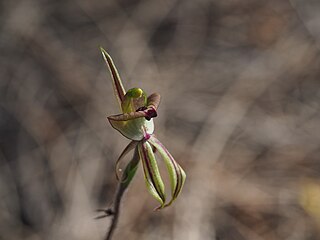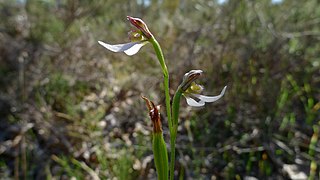
Microtis, commonly known as onion orchids or mignonette orchids is a genus of about 20 species of plants in the orchid family, Orchidaceae. Onion orchids are terrestrial herbs with a single leaf at the base of the plant. They are similar to orchids in the genus Prasophyllum in that they have an onion-like leaf. The flowers are small but often scented and attractive to their insect pollinators. They are widespread in Asia, Australia and some Pacific islands.

Caladenia brevisura, commonly known as the short-sepalled spider orchid, is a plant in the orchid family Orchidaceae and is endemic to the south-west of Western Australia. It is a common, small-flowered orchid with an erect, hairy leaf and a single greenish flower with red markings, on a flowering stem up to 25 cm (10 in) high. It is found between Ravensthorpe and Israelite Bay.
Cyanicula gertrudae, commonly known as the pale china orchid, is a plant in the orchid family Orchidaceae and is endemic to the south-west of Western Australia. It has a small, oval leaf and one or two pale blue, sweetly-scented flowers. It is similar to Caladenia gemmata but its leaf is green on both surfaces, the flower is scented and the labellum is striped.

Microtis media subsp. media, commonly known as the common mignonette orchid, is a species of orchid which is endemic to the south–west of Western Australia. It is a common, widespread orchid with a single smooth, tubular leaf and a flowering spike with up to one hundred small green flowers. It differs from Microtis media subsp. densiflora in the shape of its flower spike and the shape of its labellum.
Prasophyllum odoratissimum, commonly known as the scented leek orchid or fragrant leek orchid, is a species of orchid endemic to Western Australia. It has a single smooth, tubular leaf and up to thirty or more scented, greenish, white and fawn-coloured flowers with a labellum which is often bent backwards. It was formerly included in Prasophyllum odoratum.
Microtis alba, commonly known as the white mignonette orchid or slender onion-orchid, is a species of orchid endemic to the south-west of Western Australia. It has a single hollow, onion-like leaf and up to sixty small, green and white flowers with a strong musky fragrance. It is much more common after a fire the previous summer than in unburned country.
Microtis atrata, commonly known as the swamp mignonette orchid or yellow onion orchid and sometimes as Microtidium atratum, is a species of orchid endemic to southern Australia. It has a single thin leaf and up to forty or more yellowish-green flowers. The flowers are the smallest of any Australian ground-dwelling orchid. The orchid usually grows in large colonies after fire and although small, are easily seen because of their very large numbers in their blackened surroundings.
Microtis brownii, commonly known as the sweet mignonette orchid or sweet onion orchid, is a species of orchid endemic to the south-west of Western Australia. It has a single hollow, onion-like leaf and up to sixty small, green and white scented flowers well-spaced along the flowering stem. It usually grows in swampy places, flowers more prolifically after summer fires and sometimes forms very large colonies.

Microtis cupularis, commonly known as the cupped mignonette orchid sometimes as Hydrorchis cupularis, is a species of orchid endemic to the south-west of Western Australia. It has a single thin, hollow, onion-like leaf and up to thirty small, yellowish-green and red flowers. The plants often grow in shallow water and are self-pollinating.
Microtis media subsp. densiflora, commonly known as the dense mignonette orchid, is a species of orchid which is endemic to the south–west of Western Australia. It has a single smooth, tubular leaf and a flowering spike with up to one hundred and fifty small yellowish-green flowers. It differs from Microtis media subsp. media in the shape of its flower spike and the shape of its labellum.
Microtis quadrata, commonly known as the south coast mignonette orchid or south coast onion orchid, is a species of orchid endemic to south-west coastal areas of Western Australia. It has a single thin, hollow, onion-like leaf and up to one hundred small, pale green flowers. This onion orchid grows on low mounds in swamps, often with other species of mignonette orchids, and flowers much more prolifically after fire.
Microtis eremaea, commonly known as the slender mignonette orchid or inland onion orchid is a species of orchid endemic to the south-west of Western Australia and western South Australia. It has a single thin, hollow, onion-like leaf and up to fifty small greenish-yellow flowers. The flowers have a distinctive heart-shaped labellum and the orchid generally grows in more inland areas than most other onion orchids.
Microtis eremicola, commonly known as the desert mignonette orchid or dryland onion orchid, is a species of orchid endemic to the south-west of Western Australia. It has a single hollow, onion-like leaf and up to fifty small, dull green to greenish-yellow flowers. This onion orchid is common in soil pockets on granite outcrops in inland areas, mostly between Hyden and Balladonia.
Microtis familiaris, commonly known as the coastal mignonette orchid or coastal onion orchid is a species of orchid endemic to the south-west coastal region of Western Australia. It has a single hollow, onion-like leaf and up to twenty small, green to greenish-yellow, sweetly scented, widely spaced flowers. It often grows with large populations of other Microtis orchids but only flowers after fire.
Microtis globula, commonly known as the globular mignonette orchid or globular onion orchid is a species of orchid endemic to the south-west coastal region of Western Australia. It has a single hollow, onion-like leaf and up to thirty five small greenish-yellow, almost globe-shaped flowers. It often grows in large colonies but only flowers after hot fires the previous summer.
Microtis graniticola, commonly known as the granite mignonette orchid or granite onion orchid is a species of orchid endemic to the south-west of Western Australia. It has a single thin, hollow, onion-like leaf and up to sixty small green to greenish-yellow flowers. It grows in soil pockets on granite outcrops, especially where the soil receives run-off during rainy weather.

Microtis orbicularis, commonly known as the dark mignonette orchid, is a species of orchid endemic to southern Australia. It has a single thin, more or less hollow, onion-like leaf and up to fifty small yellowish-green and red flowers. The plants grow in winter-wet areas, often in shallow water and unlike the similar M. cupularis do not turn black as they dry.
Microtis pulchella, commonly known as the beautiful mignonette orchid or beautiful onion orchid, is a species of orchid endemic to the south-west of Western Australia. It has a single hollow, onion-like leaf and up to twenty five white, thinly textured flowers with a slight perfume. It only flowers after fire and only sometimes produces short, thread-like leaves in the absence of fire.
Eriochilus dilatatus subsp. brevifolius, commonly known as the blunt-leaved bunny orchid, is a plant in the orchid family Orchidaceae and is endemic to Western Australia. It has a single small, smooth leaf with wavy edges and a pale red lower surface, and up to three greenish and white flowers with red or mauve markings. It is distinguished from the other subspecies by the colour of the lower surface of its leaf and by its later flowering period.

Eriochilus dilatatus, commonly known as the white bunny orchid, is a plant in the orchid family Orchidaceae and is endemic to Western Australia. It is a common and widespread, slender ground orchid with a single leaf and up to fifteen small white and greenish flowers with reddish or brownish markings and a hairy labellum.






